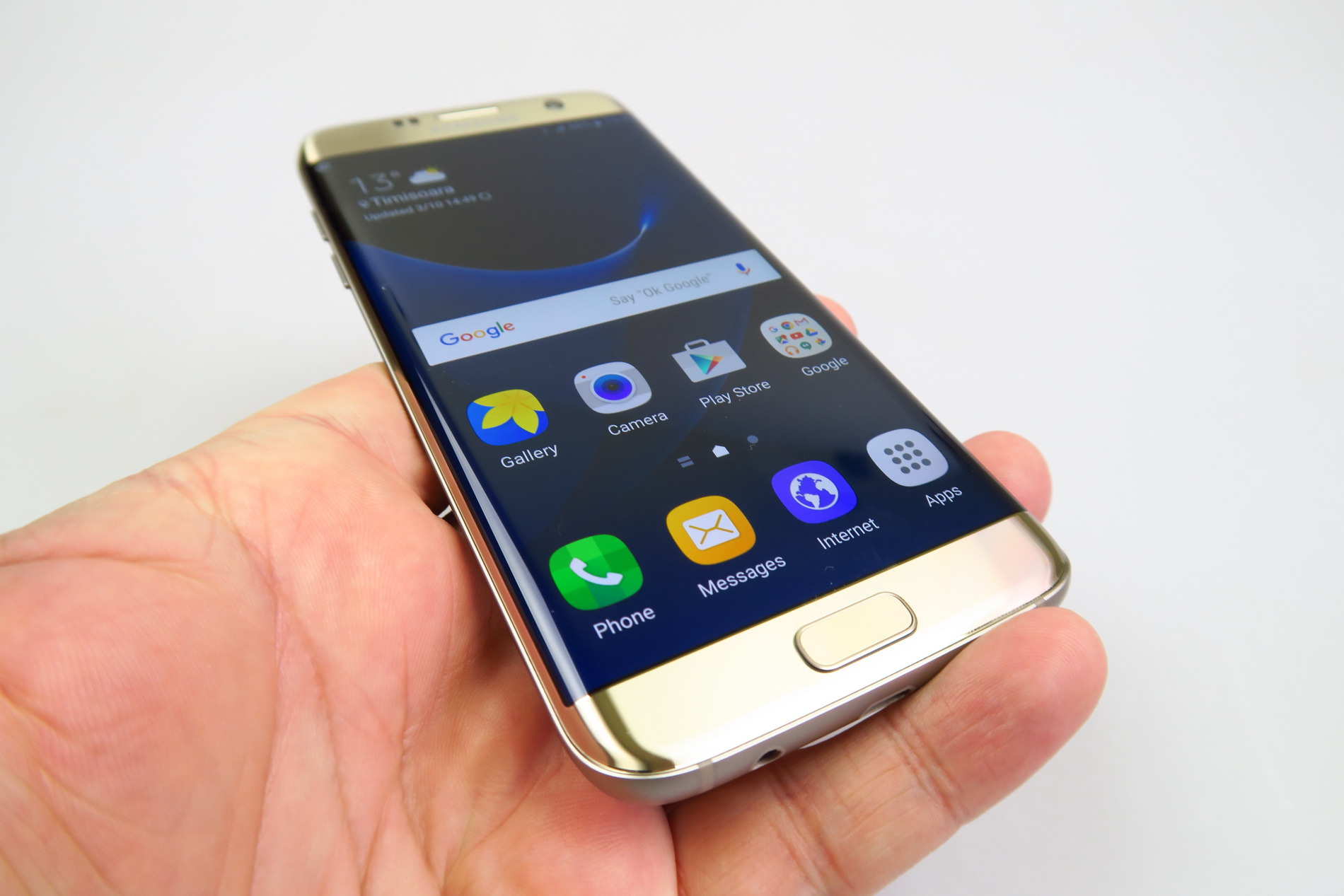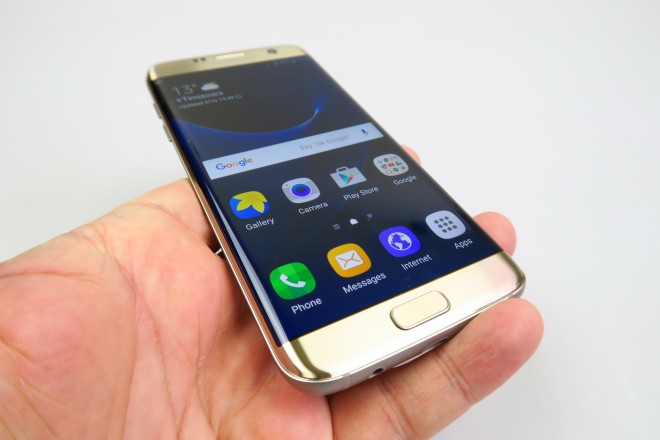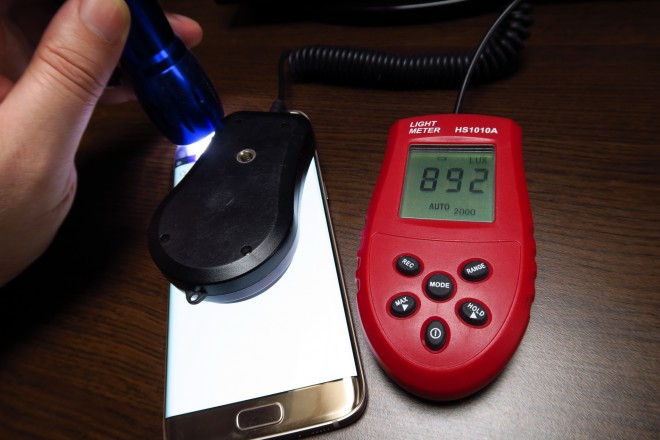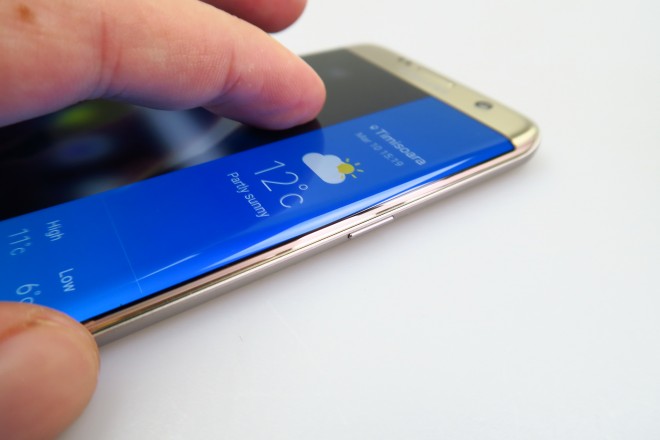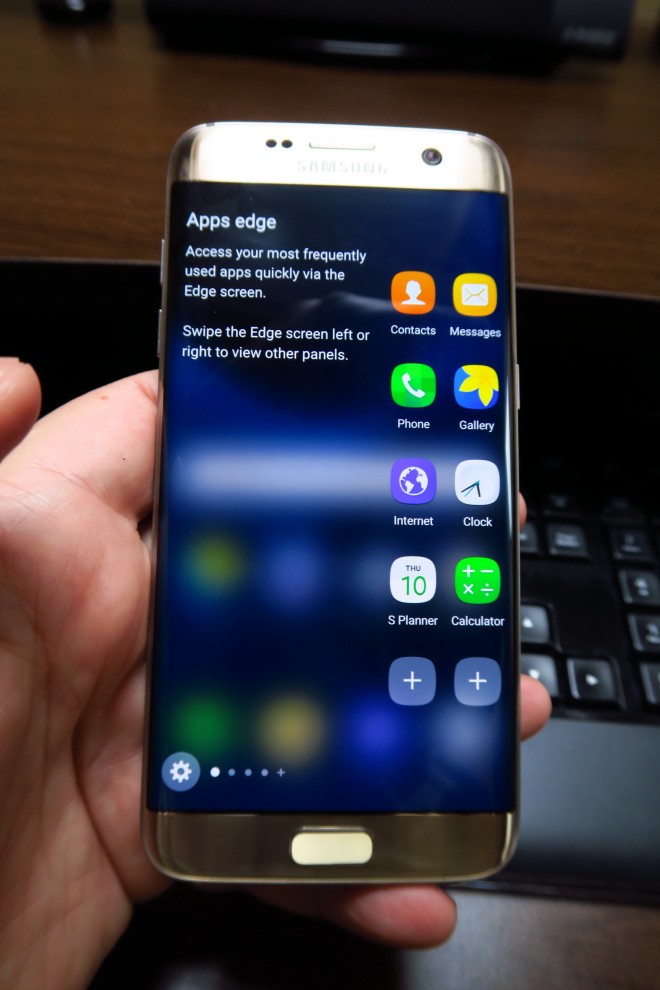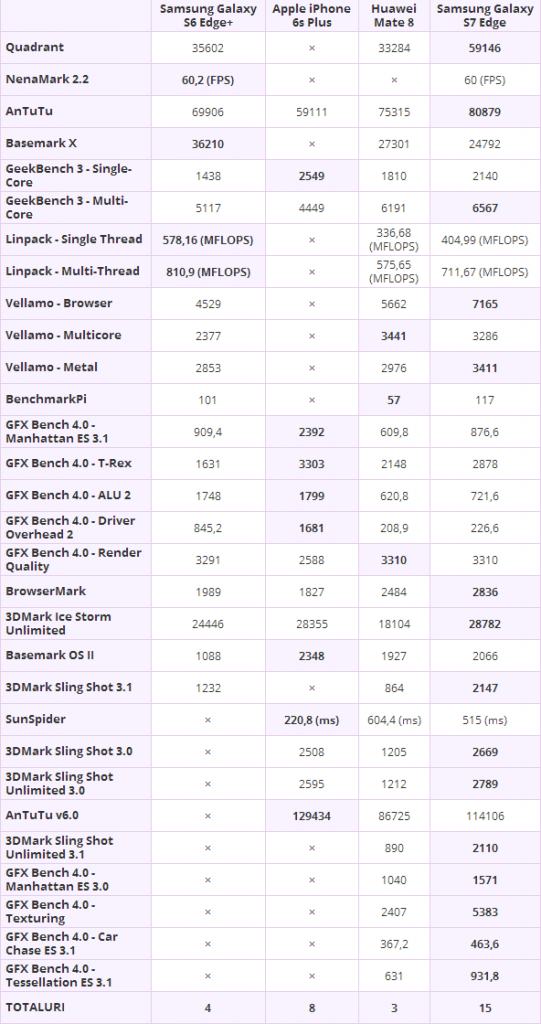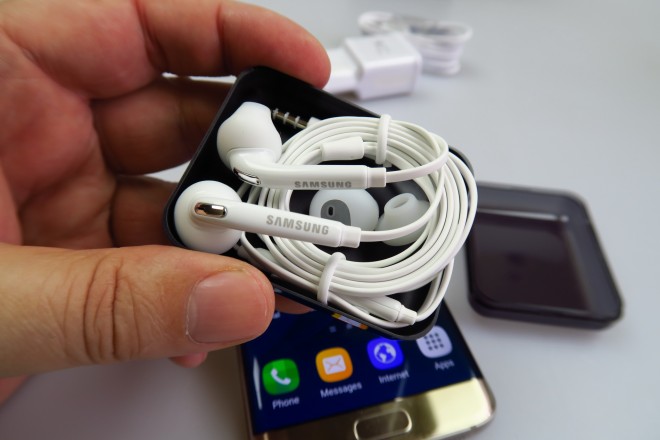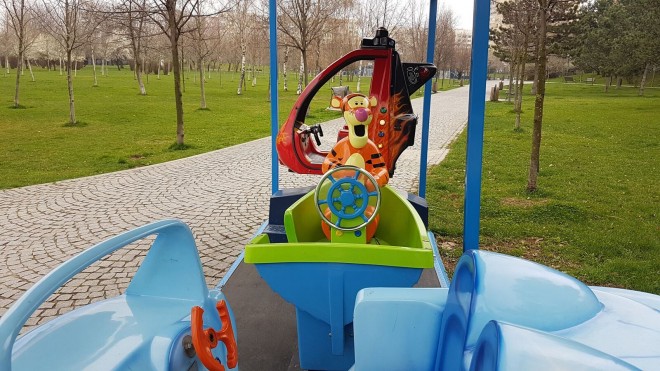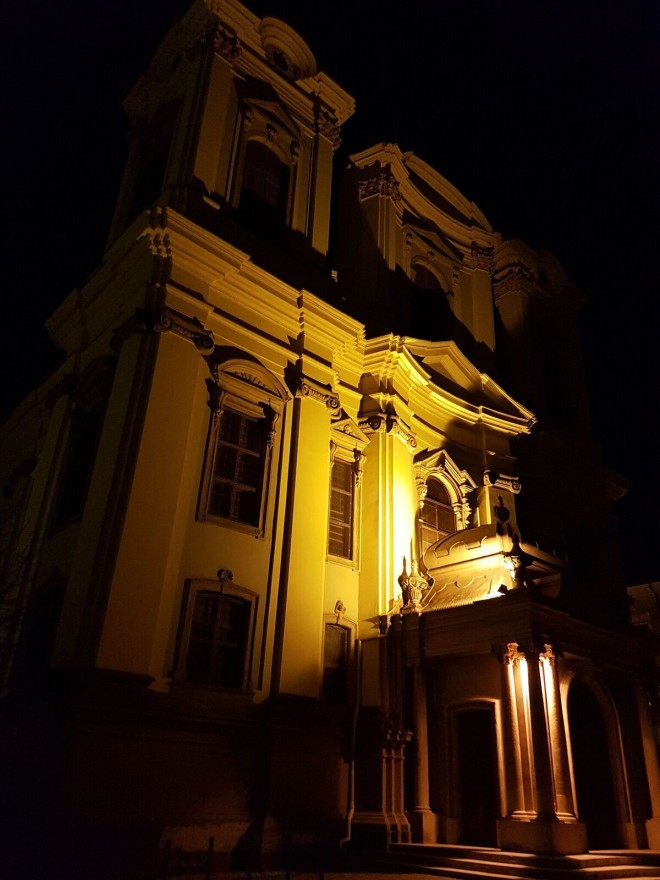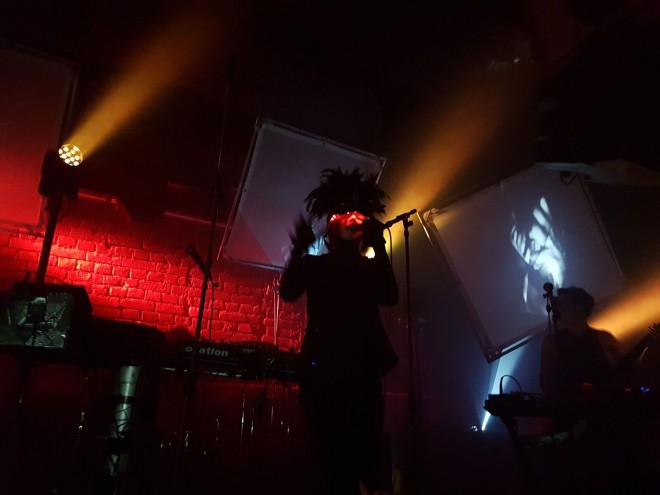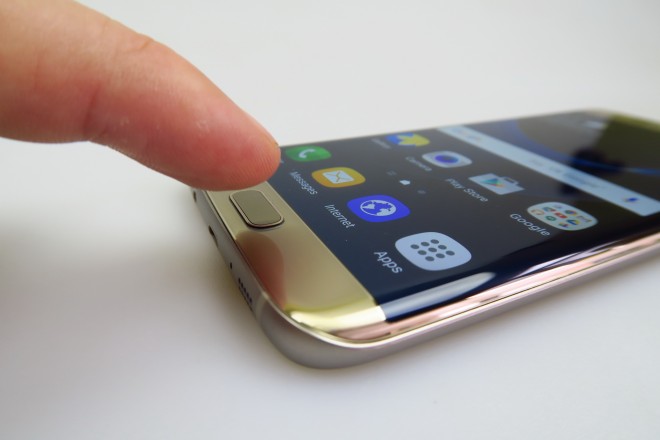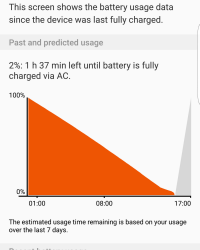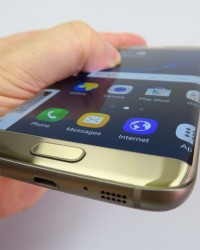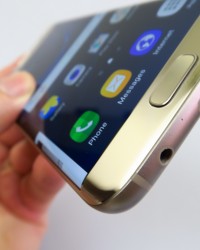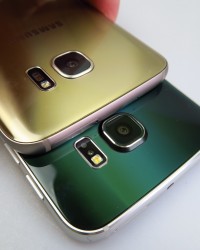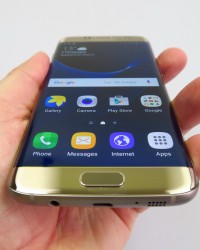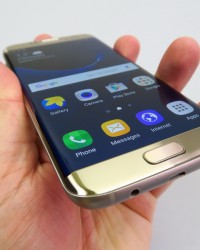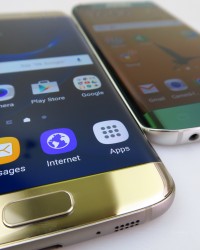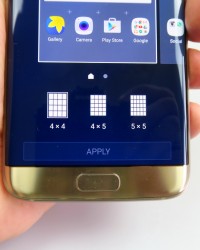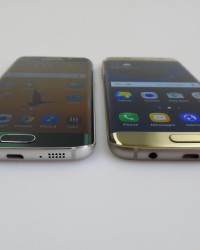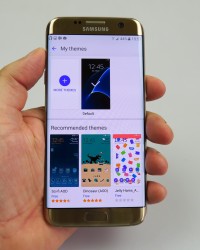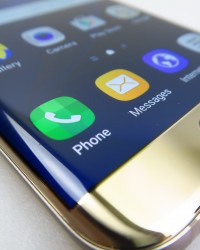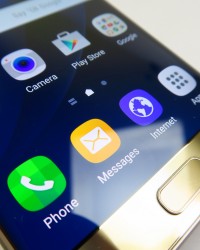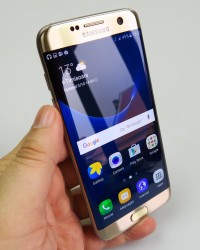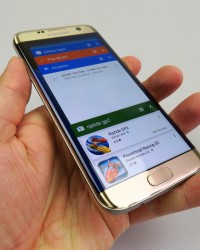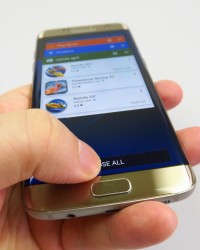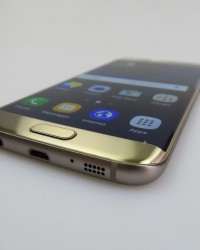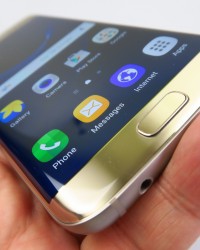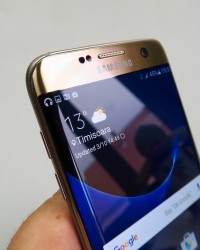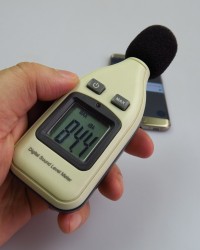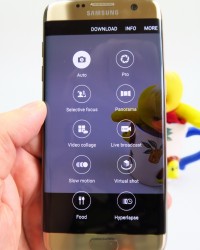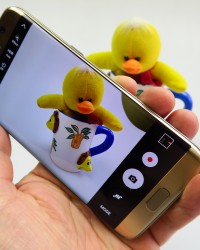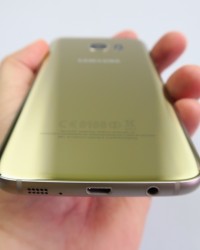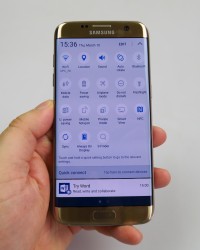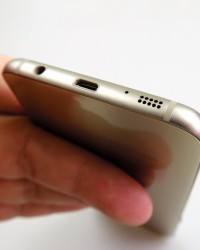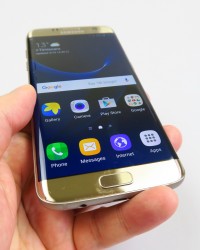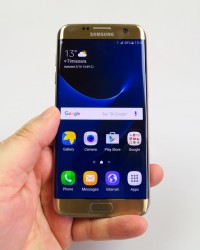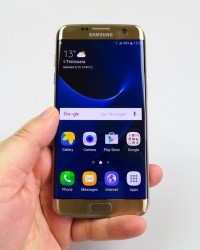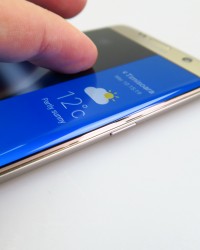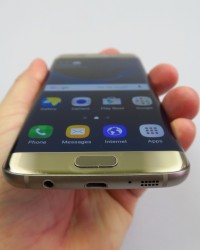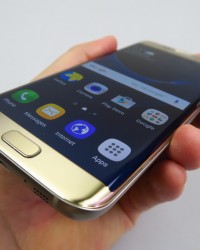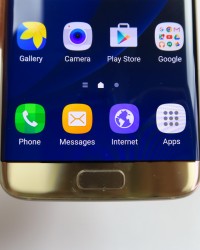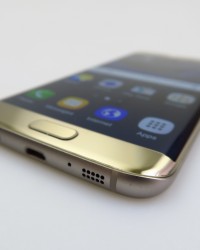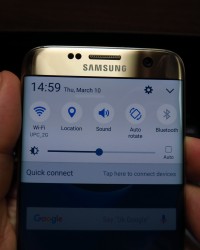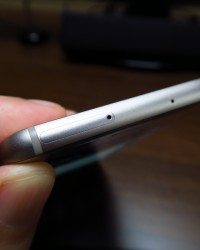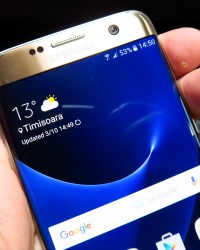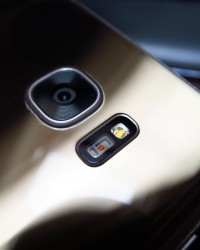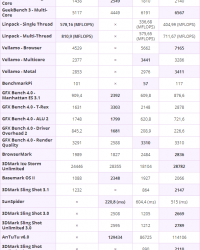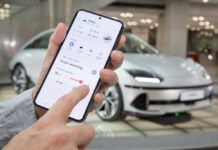Samsung Galaxy S7 Edge is the curved edge version of the Galaxy S7, both flagships being announced at MWC 2016 last month. They started shipping to customers last week and the Galaxy S7 Edge continues the tradition of a beautiful design, taken from the Galaxy S6 Edge and refined. We’re testing the Exynos version of the phone, in the gold color. This model is priced between $750 and $800.
It received preorders that bundled it with a Samsung Gear VR headset, just so you know. The Galaxy S6 Edge was a superb device and the Galaxy S7 Edge somehow manages to be better. It’s now less slippery on account of a slightly protruding metal frame and it’s very easy to get used to this format. The back is made of glass and uses a panel with curved edges, like the Galaxy Note 5.
The front side also features a glass panel with curved sides, but this time we also get smaller corners and a more rounded top and bottom area, compared to the predecessor. This feels like a more refined version of the S6 Edge. The handset measures 7.7 mm in thickness, which is 0.2 mm slimmer than the Galaxy S7 and 0.7 mm thicker than the S6 Edge.
The weight is 157 grams, which is 5 grams more than the Galaxy S7 and 4 grams more than the S6 Edge+. The phone hits the sweet spot between the Galaxy S6 Edge and the S6 Edge+, on account of its 5.5 inch diagonal. The back side of the gold version is a fingerprint magnet, probably the only bad thing one can say about this design. Samsung used 3D glass here and the body is resilient to water and dust this time, unlike the S6 and S6 Edge. This functionality returns for the first time since the Galaxy S5.
The S7 Edge can be sunken in up to 1.5 meters of water for up to 30 minutes. It’s available in black, gold, white or silver and has a smaller camera bulge compared to the predecessor. It’s the best design of 2016 so far, for sure. Now as far as hardware goes, the handset packs a 5.5 inch Quad HD Super AMOLED screen, with dual curved edges and there’s no Video app or player preinstalled.
We had to use the Gallery for that purpose and it also offers Pop up Play and pinch to zoom functionality. The viewing experience is quite special, since the apparent absence of edges, makes the image seem to float into thin air from the upper and lower area and that heightens the experience. The screen is very bright, colors are very vivid and the blacks are deep.
View angles are wide and the contrast and so is sunlight behaviour. Pixels are of the Pentile Matrix Diamond Shape variety and then we proceeded to a brightness test, achieving 581 LUX indoors and 892 LUX with the sensors submitted to a very bright light source. Those results are great and I imagine that we’re pretty much close to the 933 LUX of the S6 Edge in full sunlight, or even past it.
We surely beat the latest iPhones and the Galaxy S6 Edge+. Settings for the display include an Always on Display feature, that’s a novelty and shows the clock, calendar and image even in standby mode, using about 1% of the battery every hour. The usual modes for screen usage are here, including Adaptive Display, AMOLED Cinema for a more oversaturated experience and AMOLED Photo and Basic for more realistic/flat colors.
Now let’s talk about those Edge features. First, we’ve got the Edge Panels, that are basically mini homescreens shown onto the curved edges and part of the main screen. You get double the amount of space now compared to the Galaxy S6 Edge and S6 Edge+, but only one edge can be used at a time. Those areas can show app shortcuts, tasks (take a selfie, compose mail and more, straight from the shortcut), People Edge (list of contacts), Yahoo News, Quick Tools (compass, flashlight and ruler), Weather, Stocks, Calendar and My places.
More can be downloaded, including some that cost money. You can set the position of the edge virtual bookmark (right, left, lower or higher), and its size and transparency. Then we got the Edge Feeds, that are triggered when the device is in standby mode and show calls and mails, a flow of news, steps taken, sports scores and other such info. More feeds can be downloaded here too.
Then we’ve got Edge Lighting, that lights up the edges when the phone is facing down and each contact may get its own lighting pattern. While the features have improved from last year, they may also arrive with the latest updates on the Edge devices, so we’re not exactly getting groundbreaking features here. The software use of the edges still feels gimmicky a bit.
We continue the analysis of hardware, by having a glance at the Qualcomm Snapdragon 820 processor or the Exynos 8890, depending on where you live. For example, the Snapdragon 820 version is available in USA, China or Japan. We have the Exynos 8890 version, that’s an octa core setup, including 4 cores of the M1 kind at 2.6 GHz and 4 cores of the Cortex A53 kind, at 1.6 GHz.
There’s also a Mali T880 MP12 GPU in the mix and obviously the phone has no lag and offers high performance. There are 4 GB of LPDDR4 RAM in the mix, 32 or 64 GB of storage and a microSD card slot, that’s a new addition, that the S6 Edge and S6 Edge+ didn’t get. Performance is once again great and in the benchmarks we pretty much won all duels. S7 Edge is placed first in Quadrant, compared to any phone we’ve tested, also first in the older AnTuTu, in 3DMark and Vellamo, but in the newer AnTuTu it’s second after the iPhone 6S Plus. Here are some benchmark comparisons:
This beast of a phone runs any game perfectly, from GTA to Asphalt and FIFA and it’ll probably keep doing that for 2-3 years. After playing the game Riptide GP2 we got to a temperature of 34 degrees Celsius, which means there’s no overheating. Talking about acoustics, we find the singular speaker at the bottom and this time we don’t get a dedicated Samsung music player, but have to resort to Google Play Music instead.
The equalizer settings are the same as before, including knobs to give an extra twist to instruments, vocals and treble, plus the new UHQ Upscaler for enhancing the music resolution, surround and Tube Amp options, as well as 7 frequency sliders. The speaker experience was loud and clear, bass was great and all the notes were heard perfectly.
It feels that this speaker is superior to the one of the iPhones and our decibelmeter showed a value of 84.4 dBA, which beats the iPhone 6S Plus and Huawei Mate 8, but scores below the S6 Edge+. The headphones are the same ones from last year’s S6, but they’re comfy, have a flat and tangle free wire, great bass and excellent volume and isolation.
Now with the great acoustics out of the way, let’s talk about the camera. Samsung Galaxy S7 Edge packs a 12 megapixel camera, which may feel like a downgrade from the Galaxy S6 Edge and S6 Edge+ 16 MP cameras. There are actually two camera versions of the S7 Edge and S7, one with a Sony sensor and one with a Samsung sensor. We have the Samsung one.
The cam uses Dual Pixel technology, which also appears on the DSLRs, like the Canon 70D and means that each pixel has 2 photo diodes that be read independently during focus, or can be read together. Galaxy S7 Edge comes with optical image stabilization, F/1.7 aperture, single LED flash and Phase Detection Autofocus, as well as 1.4 micron pixels.
Upfront there’s a 5 MP camera, also with F/1.7 aperture. The camera UI is virtually unchanged from the last year models and from the Galaxy A7 (2016). The app opens up very fast, especially when it’s started with a double press of the Home button. The Capture Modes are as follows: Pro, Auto, Selective Focus, Panorama, Video Collage, Live Broadcast, Virtual Shot, Food and Hyperlapse.
The only novelty is the last of them, Hyperlapse being a cinematic video timelapse, with excellent stabilization and tweakable speed. The camera itself offers ultra fast focus and fast capture. You can also create a motion photo, basically something like Apple’s live photos, a 3 second video before you shoot a picture.
The Pro mode includes a Shutter speed between 1/24.000 seconds and 10 seconds, like the S6 Edge+, so nothing really new here. RAW capture is also available. We took a huge amount of pictures with this phone, including a set during a sunny day, one during a cloudy day, one at night and one at an IAMX concert in Bucharest. Those taken in sunny conditions (gallery) include some DSLR-worthy closeups, but we did register some quality loss when zooming in.
There were also some sun burnt frames, but otherwise clarity and details were excellent. Colors and textures were also good, but if you have a powerful sun at the corners of you line of sight, expect to get some sun burnt shots, at least in the Samsung camera sensor version. The Sony one may do better. I also felt that the S6 Edge could handle sun better and burnt pictures much less.
Quality was equal to the latest iPhones and Huawei Mate 8, but the closeups were totally ace. During that cloudy setup and indoors (gallery here), we still had some blurred shots, but texture was excellent for those cocktails and lighting was also good. I felt that the cloudy day captures could’ve been better and found them somewhat lacking in details.
HDR was quite good and generally the clarity was OK, although in landscape shots of large areas, you could see tree leaves blurring out of detail. This cam is certainly not able to capture the same amount of details like a 21 MP shooter. Panorama is generous, with a res of 23984 x 2144 pixels and I frankly couldn’t understand the layer of white that came across some of the shots.
Anyway, colors were realistic, maybe even more than the LG G4 and the selfies featured a very natural skin, but the background was very blurred and poorly shown. The S6 felt like it took better selfies. So did the iPhone 6s and 6s Plus. I never had one bit of problem with focus, so that aspect is well taken care of on the Galaxy S7 Edge, at least.
However, the camera really went wild during the low light capture, at night (gallery here). We had great quality shots in lower light, both indoors and outdoors. It was as if another camera was used, one able to beat the LG G4 and compete with the excellent Huawei Mate 8 in poor lighting. There was no grain, no yellow hues and no huge street light halos.
Everything looked perfect at night, with excellent building textures and even the stars in the sky looked nice. Then came the ultimate test, as we used the phone to take shots at an IAMX concert indoors, in Bucharest (gallery here). The resulting shots were good enough for an alternative music magazine, so that’s got to count for something. There was intermittent lighting and smoke in our way and still the shots were great.
I’d say it beats any other camera I’ve shot a concert with, like ever. The big evolution from the S6 Edge to the S7 Edge is in the night time and low light capture it would seem. As far as video goes, we shot MP4 clips, in Full HD at 30 or 6 FPS and in 4K, with a bitrate of 49 Mbps. It seems that the microphones can’t face the wind on a Spring day, but it could easily face the huge bass and tons of decibels in the concert room.
When filming, colors were realistic, more realistic than the artificial Huawei Mate 8, that’s for sure. Hyperlapse looked nice and optical image stabilization was one of the best I’ve seen, without too much extra movement or focus loss. Brightness was good, even at night, but in low light things got a bit shaky and grainy at times.
The concert video capture was perfect, in spite of all the smoke, movement and lighting. However, the general feeling was that the video capture hasn’t evolved much from the S6 Edge, which also did a fine job in the video capture area. Once again, low light capture may be the difference here, in favour of the newer model. I also feel that these videos aren’t exactly miles away from the iPhones, that do a fine job as well.
Then we went on to test the web browser, that offered an OK speed and great benchmarks, at least Chrome did. The virtual keyboard is comfy and we’ve got a row of numeric buttons for comfier input. On the connectivity front, there’s an Extra Volume Mode, that deals with noisy areas and we got some very loud and clear calls on this unit.
Noise canceling is great and there’s also support for 4G LTE Category 12/13, WiFi 802.11 a/b/g/n/ac MIMO and Bluetooth 4.2. MicroUSB, GPS and NFC round up the list, while WiFi got to 26 Mbps in download and the same speed in upload, in our tests. Now it’s time to see what the battery has in stall for us. First, it’s a clearly upgraded unit from the 2600 mAh of the S6 Edge, now at 3600 mAh in capacity.
Thus, it’s no wonder we got a huge HD video playback time of 15 hours and 15 minutes, beating all phones minus the battery phones we’ve tested. It even beats the iPhone 6S Plus, that had an excellent battery last year. In PCMark we also had a great score of 9 hours and 17 minutes, surpassing the likes of Huawei Mate 8, Galaxy Note 5 and Galaxy S6 Edge+.
Charging requires 1 hour and 33 minutes and while it’s great, it’s not 1 hour and 5 minutes like the S6 Edge+. There’s also wireless fast charging available and we’ve got the usual Power Saving and Ultra Power Saving features. Now let’s dissect the OS, UI and apps. The phone runs Android 6.0.1 Marshmallow, with the latest Touchwiz on top.
Changes from Galaxy S6 Edge and S6 Edge+ aren’t huge and the UI is fluid. We’ve got a white dropdown area and a carousel multitasking section. There’s also split screen multitasking, with the option to split the screen in two to use two apps at the same time and drag and drop pictures and text between them. Flipboard still has its own homescreen and the widgets are very good looking.
Themes are also here and they’re quite nice, a breath of fresh air compared to the usual UI. You can disable the app drawer and in the Settings area you can find the favourite settings at the top part of the list, plus Advanced Features, like one hand use, Pop Up View (pop up play for all apps basically), Easy Mode and Game Tools/Launcher.
This is a new feature that offers special functions for games. There’s a special gaming Power Saving Mode, a special Do Not Disturb mode for gaming, the ability to take screenshots and record video from the screen and front camera at the same time during gaming and more. You can also deactivate the capacitive keys, in order not to press them by mistake.
We tested the fingerprint scanner and it was fast and accurate, but the setup was kind of long. The pulse scanner sadly wasn’t that accurate. The preinstalled apps list includes 38 apps, with the likes of S Health, S voice and S Planner included. Word, Excel and Powerpoint are bundled, plus the Google suite and other basic stuff, but no bloatware.
And now it’s time for the verdict!
Here are the Pros:
superb design
bright screen
great performance
nice Game Launcher/Tools
great acoustics
powerful hardware
excellent battery
great low light capture
great OIS
And the Cons:
camera version discrepancies (Sony/Samsung)
fingerprint magnet back
pictures taken on sunny day could be better
microphone can’t handle the wind
video capture could be better during the day
Overall, the Galaxy S7 Edge feels like a refined and more beautiful S6 Edge, with a sweet spot format, more powerful hardware (but not with a huge difference), however packing a much more potent battery. The gaming features and low light camera stand out of the crowd as appealing feats. Of course we’ve also got the curved edges, but they’re more for show than useful. It’s hard to imagine a better Android phone right now, so this is the best flagship of the moment, among all we’ve tested. Updated price is here.

